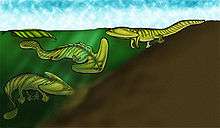Diploceraspis
| Diploceraspis Temporal range: 299–270 Ma Early Permian | |
|---|---|
 | |
| Scientific classification | |
| Kingdom: | Animalia |
| Phylum: | Chordata |
| Class: | Amphibia |
| Subclass: | Lepospondyli |
| Order: | Nectridea |
| Family: | Keraterpetontidae |
| Genus: | Diploceraspis Beerbower, 1963 |
| Species: | D. burkei |

Diploceraspis group
Diploceraspis was a lepospondyl amphibian. It lived in Ohio and West Virginia during the Permian period. It closely resembles its relative, Diplocaulus. It generally sports the same features as Diplocaulus, though it was smaller, measuring over 46 cm.[1] Beerbower originally recognised two species, D.burkei and D.conemaughensis, but they are no longer regarded as being distinct as their size ranges were found to overlap, leaving D.burkei as the only known species.[2]
References
- ↑ http://www.angellis.net/Web/PDfiles/amphs.pdf
- ↑ Germain D. (2010). "The Moroccan diplocaulid: the last lepospondyl, the single one on Gondwana". Historical Biology. 22 (1-3): 4–39. doi:10.1080/08912961003779678.
This article is issued from
Wikipedia.
The text is licensed under Creative Commons - Attribution - Sharealike.
Additional terms may apply for the media files.